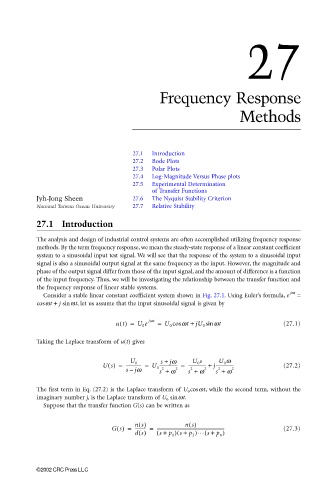Page 840 - The Mechatronics Handbook
P. 840
0066_frame_C27 Page 1 Wednesday, January 9, 2002 7:10 PM
27
Frequency Response
Methods
27.1 Introduction
27.2 Bode Plots
27.3 Polar Plots
27.4 Log-Magnitude Versus Phase plots
27.5 Experimental Determination
of Transfer Functions
Jyh-Jong Sheen 27.6 The Nyquist Stability Criterion
National Taiwan Ocean University 27.7 Relative Stability
27.1 Introduction
The analysis and design of industrial control systems are often accomplished utilizing frequency response
methods. By the term frequency response, we mean the steady-state response of a linear constant coefficient
system to a sinusoidal input test signal. We will see that the response of the system to a sinusoidal input
signal is also a sinusoidal output signal at the same frequency as the input. However, the magnitude and
phase of the output signal differ from those of the input signal, and the amount of difference is a function
of the input frequency. Thus, we will be investigating the relationship between the transfer function and
the frequency response of linear stable systems.
Consider a stable linear constant coefficient system shown in Fig. 27.1. Using Euler’s formula, e =
jωt
cosωt + j sinωt, let us assume that the input sinusoidal signal is given by
ut() = U 0 e jwt = U 0 cos wt + jU 0 sin wt (27.1)
Taking the Laplace transform of u(t) gives
s + jw U 0 s U 0 w
---------------- =
Us() = ------------- = U 0 2 ---------------- + j---------------- (27.2)
U 0
2
sjw s + w 2 s + w 2 s + w 2
2
–
The first term in Eq. (27.2) is the Laplace transform of U 0 cosωt, while the second term, without the
imaginary number j, is the Laplace transform of U 0 sinωt.
Suppose that the transfer function G(s) can be written as
ns() ns()
Gs() = ---------- = ------------------------------------------------------------- (27.3)
ds() ( s + p 1 ) s +( p 2 ) … ( s + p n )
©2002 CRC Press LLC

